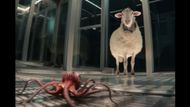Alien: Earth came in carrying the weight of the Alien legacy, now stretched into a weekly slot on FX and streaming on Hulu. It was expected to bring new monsters, more of Weyland-Yutani’s shadowy influence, and that tense atmosphere the franchise is known for. But then something else appeared on screen, something no one had on the list. A sheep. And suddenly the focus shifted.
Timothy Olyphant, who plays the synth Kirsh, recalled in an interview with Entertainment Weekly that the cast even made shirts featuring the animal. “And you know who's on the front of that shirt? That f---ing sheep,” he said, pointing out that what began as a minor part of the story quickly turned into something bigger. His remark set the tone for how the production team and the audience would eventually perceive the animal’s impact.
The idea that a plain lab sheep could steal the spotlight in a world built with so much darkness and precision feels strange at first. Yet that’s what happened. What looked like nothing more than a background detail slowly grew into one of the season’s main talking points, proof that the show knows how to throw in a surprise where nobody expects it.

The episode that shifted perception
By the time episode four aired, the sheep had already caught attention for its oddly expressive moments. The turning point came when Boy Kavalier, played by Samuel Blenkin, and his team placed a tentacled alien organism from a Weyland-Yutani vessel into the same cell as the animal.
What followed was disturbing: the creature removed the sheep’s eye and lodged itself inside the empty socket. Through its tendrils, it connected to muscles and nerves and began controlling the body. The scene turned the sheep into a central figure of the narrative.
Building the creature
Series creator Noah Hawley explained the creative decision behind the moment. He described how the Alien franchise has long explored revulsion toward parasites and facial invasion.
“So I just moved up two holes. I just went up to the eye,” he said.
By shifting the point of entry to the eye, the show introduced a new layer of discomfort, echoing the horror of the classic facehugger while presenting a variation that felt original.

Humor and unease
The unusual balance between horror and amusement also became part of the discussion. The gruesome takeover of the animal’s body was hard to watch, but there was another layer behind the scenes. Olyphant recalled that shirts printed with the sheep and its enlarged eye became popular on set, creating a running joke during production. His summary was simple: “I was a big fan of the sheep.”
Alien: Earth and the troubling symbol of control
Hawley linked the scene to deeper psychological fears. He mentioned his unease with the idea of general anesthesia, where the body acts without consciousness or memory. The concept inspired the way the parasite takes control. The showrunner also pointed out that the series never clarified whether part of the host might remain aware of what was happening. That ambiguity adds to the impact and leaves the sheep as a troubling symbol of violation and control.

Reactions and behind the scenes
The animal’s sudden prominence also influenced the atmosphere among the cast. Olyphant admitted that it sometimes felt difficult to compete for attention.
“I'm telling you, man, this is one of those gigs where it's hard to demand the millions of dollars that you'd like to get because the monster is No. 1 on the call sheet. He's not even on the call sheet, but, you know, he's the star.”
The comment reinforced the idea that the sheep, despite not even being on the official list, had stolen the spotlight.
Continuing the series
Alien: Earth continues to air every Tuesday at 8 PM on FX and on Hulu at the same time. Each week new episodes add more layers of tension, developing creatures and scenarios that stretch the limits of body horror. The sheep episode has already become a reference point for the season, remembered as one of the clearest examples of how the series is willing to go further than expected.

Conclusion
The unusual rise of a sheep as the standout presence in a science fiction horror series underscores how Alien: Earth has managed to generate surprises. Olyphant’s candid remarks and Hawley’s explanation highlight that the decision was not simply visual shock but a creative way to revisit fundamental fears.
The sheep taken over by the parasite ended up as one of the season’s most striking images, the kind that lingers after the episode is over. On set, the team even started calling it the real star of the show. Moments like this show how Alien: Earth can push the franchise into new territory while still holding on to the uneasy tone that made it famous in the first place.
